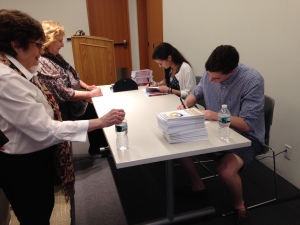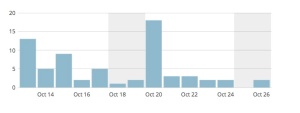I am wrapping up the project I started a year ago when I approached a small group of science students and asked them if they would like to learn to write a book. Each of them was doing a special research project, so they had ample material to write about. I had just finished my own first book, and I explained to them that I could show them the steps to write and self publish their own books. I ended up with three dedicated students, all of whom have now published their own books. Each is unique, and all are interesting:
 Jen Schwartz published On the Right Track: A Student’s Memoir of Research, Advancement, and Holding on to Hope (Click title to buy this book)
Jen Schwartz published On the Right Track: A Student’s Memoir of Research, Advancement, and Holding on to Hope (Click title to buy this book)
 John Diorio published Broadening the High School Experience:A Student’s Perspective on Independent Exploration (Click title to buy this book)
John Diorio published Broadening the High School Experience:A Student’s Perspective on Independent Exploration (Click title to buy this book)
 Alexandra DiGiacomo published A Familiar Fin (Click title to buy this book)
Alexandra DiGiacomo published A Familiar Fin (Click title to buy this book)
This was a pilot project for me, so I am assessing how it went and how to improve it when I do it again. What worked well were the overall plan I used, and getting the student authors to work together. Some things to improve:
- The students liked collaborating and sharing their work with one another, but the time was difficult to find to do this often–next time, I will plan more time for mutual editing and reviewing.
- The review process, especially around the final copy editing, broke down somewhat, and I had little idea how the students were doing. We needed a day, probably a weekend, when we could have all worked in a room and gone over formatting for publication.
- Book marketing, crucial to the success of any author, but especially self published authors, has tapered off with the end of the project. Successful authors will market their books before and especially after publication. Because we ended the project at the end of the school year, we could not easily work together to push marketing after publication. More planning and an agreement on what to do ahead of time would have helped.
 Therefore, while the project was successful overall, I have many things I plan to do better next time. I documented our experience and made a step-by-step how to guide for teachers and mentors, Creating Student Authors: How to Mentor Any Student to Be a Self Published Author (click to purchase in paperback or ebook). I would love to hear from other teachers and mentors about your thoughts.
Therefore, while the project was successful overall, I have many things I plan to do better next time. I documented our experience and made a step-by-step how to guide for teachers and mentors, Creating Student Authors: How to Mentor Any Student to Be a Self Published Author (click to purchase in paperback or ebook). I would love to hear from other teachers and mentors about your thoughts.











